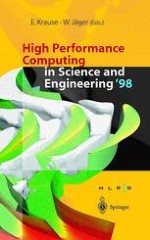1999 | OriginalPaper | Chapter
Temperature dependent band structure of the Kondo insulator
Authors : C. Gröber, R. Eder
Published in: High Performance Computing in Science and Engineering ’98
Publisher: Springer Berlin Heidelberg
Included in: Professional Book Archive
Activate our intelligent search to find suitable subject content or patents.
Select sections of text to find matching patents with Artificial Intelligence. powered by
Select sections of text to find additional relevant content using AI-assisted search. powered by
We present a Qantum Monte Carlo (QMC) study of the temperature dependent dynamics of the Kondo insulator. Working at the so-called symmetrical point allows to perform minus-sign free QMC simulations and thus reach temperatures of less than 1% of the conduction electron bandwidth. Study of the temperature dependence of the single particle Green’s function and dynamical spin correlation function shows a surprisingly intricate low temperature band structure and gives evidence for two characteristic temperatures, which we identify with the Kondo and coherence temperature, respectively. In particular, the data show a temperature induced metal-insulator transition at the coherence temperature.The theoretical description of the Kondo lattice remains an outstanding problem of solid state physics. This model, or variations of it, may be viewed as the appropriate one for understanding such intensively investigated classes of materials as the heavy electron metals[1,2] and the Kondo insulators[3]. Experimental results indicate that the electronic structures of Kondo lattice compounds undergo quite dramatic changes with temperature[4]. It is the purpose of the present manuscript to report a QMC study of the electronic structure of the so-called Kondo insulator, which shows that this model indeed undergoes a quite profound change of its unexpectedly intricate band structure as temperature increases. We are using a one dimensional (1D) ‘tight-binding version’ of the model with L unit cells and 2 orbitals/unit cell: 1$$H = - t\sum\limits_{{i,\sigma }} {(c_{{i + 1,\sigma }}^{\dag }{{c}_{{i,\sigma }}} + H.c.) - V\sum\limits_{{i,\sigma }} {(c_{{i,\sigma }}^{\dag }{{f}_{{i,\sigma }}} + H.c.)} } - {{\epsilon }_{f}}\sum\limits_{{i,\sigma }} {{{n}_{{i,\sigma }}} + } {\text{ }}U\sum\limits_{i} {f_{{i, \uparrow }}^{\dag }{{f}_{{i, \uparrow }}}f_{{i, \downarrow }}^{\dag }{{f}_{{i, \downarrow }}}.}$$ Here c i,σ† (f i,σ†) creates a conduction electron (f -electron) in cell i, n i,σ =f i,σ†f i,σ. Throughout we consider the case of ‘half-filling’ i.e. two electrons/unit cell and, as an important technical point, we restrict ourselves to the symmetric case, ∈ f =U/2. The latter choice, while probably not leading to any qualitative change as compared to other ratios of ∈ f /U, has the crucial advantage that at half-filling the model acquires particle-hole symmetry, i.e. the Hamiltonian becomes invariant under the transformation α i,σ → exp(iQ • R i )α i,σ†, where α=c, f and Q=(π, π,…) (this holds for bipartite lattices with only nearest relations on the f-sites become localized, and the ‘spin gap’ closes due to c-like spin excitations. While c and f electrons seem to form a coherent ‘all-electron fluid’ below the crossover temperature, the c and f-like features in the correlation functions above this temperature are decoupled. We therefore interpret this temperature as the analogue of the coherence temperature in heavy-Fermion metals. At the high-temperature crossover both, the dispersionless f-like Kondo-resonance in the single-particle spectrum and the f-like low-energy spin excitation disappear. The only remaining f-like feature in the single particle spectrum are the high-energy ‘Hubbard bands’, corresponding to the ‘undressed’ transitions f1 → f0 and f1 → f2. We therefore interpret this second temperature as the Kondo temperature of the system.The calculations were carried out on the Cray-T3E supercomputer at the HLRS Stuttgart. The QMC algorithm ran on 64 processors with different initial configurations of the ising field [15]. Communication was used to gather the results from each processor in order to perform the statistical analysis. With this scheme a total performance of 8 Gigaflops has been achieved.
